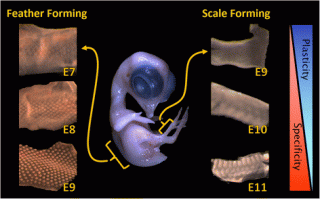Jan, 2015

Background: Regional specificity allows different skin regions to exhibit different characteristics, enabling complementary functions to make effective use of the integumentary surface. Chickens exhibit a high degree of regional specificity in the skin and can serve as a good model for when and how these regional differences begin to emerge.
Results: We used developing feather and scale regions in embryonic chickens as a model to gauge the differences in their molecular pathways. We employed cosine similarity analysis to identify the differentially regulated and co-regulated genes. We applied low cell techniques for expression validation and chromatin immunoprecipitation (ChIP)-based enhancer identification to overcome limited cell availabilities from embryonic chicken skin.
We identified a specific set of genes demonstrating a high correlation as being differentially expressed during feather and scale development and maturation. Some members of the WNT, TGF-beta/BMP, and Notch family known to be involved in feathering skin differentiation were found to be differentially regulated. Interestingly, we also found genes along calcium channel pathways that are differentially regulated. From the analysis of differentially regulated pathways, we used calcium signaling pathways as an example for further verification. Some voltage-gated calcium channel subunits, particularly CACNA1D, are expressed spatio-temporally in the skin epithelium. These calcium signaling pathway members may be involved in developmental decisions, morphogenesis, or epithelial maturation. We further characterized enhancers associated with histone modifications, including H3K4me1, H3K27ac, and H3K27me3, near calcium channel-related genes and identified signature intensive hotspots that may be correlated with certain voltage-gated calcium channel genes.
Conclusion: We demonstrated the applicability of cosine similarity analysis for identifying novel regulatory pathways that are differentially regulated during development. Our study concerning the effects of signaling pathways and histone signatures on enhancers suggests that voltage-gated calcium signaling may be involved in early skin development. This work lays the foundation for studying the roles of these gene pathways and their genomic regulation during the establishment of skin regional specificity.